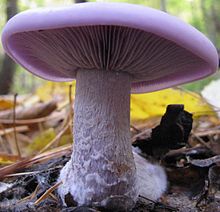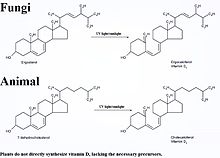Medicinal mushroom
From Wikipedia, the free encyclopedia
Medicinal mushrooms are mushrooms used in medicine or medical research.
Contents
[hide]History[edit]
Mushrooms, fermentation molds, mycelia, sclerotium, and lichens, have a history of medicinal use spanning millennia. The mushroom with the longest record of medicinal use Ganoderma lucidum, is known in Chinese as líng zhī ("spirit plant"), and in Japanese as mannentake ("10,000 year mushroom"). In ancient Japan, Grifola frondosa was worth its weight in silver.[1]
A Hadith states, "Truffles are manna which Allah sent to the people of Israel through Moses, and its juice is a medicine for the eyes."[2] Ötzi the Iceman was found carrying Fomes fomentarius and Piptoporus betulinus.[3] Inonotus obliquus was used in Russia as early as the 16th century, and it featured in Alexandr Solzhenitsyn's 1967 novel Cancer Ward.[4] Ancient Egyptians considered mushrooms food for royalty.
Fungi that do not produce mushrooms, have made large contributions to medicine being the source of immunosuppressants ciclosporin,mycophenolic acid, mizoribine, antibiotics penicillin, cephalosporins, fusafungine, usnic acid, fusidic acid, fumagillin, brefeldin A, verrucarin A,alamethicin, antifungals griseofulvin, echinocandins, strobilurin, azoxystrobin, caspofungin, micafungin, and statins lovastatin, mevastatin (pravastatinprecursor), and monacolin J (simvastatin precursor).
Medical applications[edit]
Antimicrobial isolates and derivatives[edit]
Antibiotics retapamulin, tiamulin, and valnemulin are derivatives of the mushroom isolate pleuromutilin. Plectasin, coprinol, and sparassol, are antibiotics isolated from mushrooms. Researchers have isolated a number of antifungal, antiviral, and antiprotozoan, isolates from mushrooms.
Mushroom enzyme inhibitors[edit]
| Mushroom | Isolate/extract/metabolite | Enzyme inhibited |
|---|---|---|
| Pleurotus ostreatus | lovastatin | HMG-CoA reductase |
| Hypholoma sublateritium | clavaric acid | farnesyltransferase |
| Polyozellus multiplex | polyozellin, thelephoric acid, kynapcins | prolyl endopeptidase |
| Lentinula edodes | eritadenine | S-adenosyl-L-homocysteine hydrolase |
| Coprinopsis atramentaria | 1-aminocyclopropanol | acetaldehyde dehydrogenase |
| Inonotus obliquus | extract | dipeptidyl peptidase-4 |
| Grifola frondosa | extract | alpha glucosidase |
| Trametes versicolor | extract | alpha amylase |
| Pholiota squarrosa, Daedalea quercina | extract (Pholiota squarrosa), quercinol (Daedalea quercina) | xanthine oxidase |
| Phellinus linteus | phellinstatin | enoyl-ACP reductase |
| Phellinus linteus | hispidin and hypholomine B | neuraminidase |
| Various | extract | 5-alpha reductase |
| Various | extract | aromatase |
| Various | peptides | angiotensin-converting enzyme |
| Daedalea quercina | quercinol | cyclooxygenase 2 |
| Daedalea quercina | quercinol | horseradish peroxidase |
Anticancer research[edit]
Bristol-Myers Squibb manufactures paclitaxel using Penicillium raistrickii. In 2014, researchers reported creating a transgenic Flammulina velutipes that expresses the gene used to synthesize the paclitaxel precursor baccatin III.[5]
Some mushroom extracts and isolates have been researched for anticancer activity. As examples:
- Clavaric acid is a farnesyltransferase inhibitor
- Flammulina velutipes contains asparaginase
- Irofulven and acylfulvene are derivatives of illudin S
- Agaricus contains conjugated linoleic acid
- Grifolin is an Albatrellus confluens isolate
Some countries have approved mushroom extracts lentinan, polysaccharide-K, and polysaccharide peptide as immunologic adjuvants.[6] There is some evidence of this use having effectiveness in prolonging and improving the quality of life for patients with certain cancers, although the Memorial Sloan-Kettering Cancer Center observes that "well designed, large scale studies are needed to establish the role of lentinan as a useful adjunct to cancer treatment".[7] According to Cancer Research UK, "there is currently no evidence that any type of mushroom or mushroom extract can prevent or cure cancer".[8][9]
Antidiabetic research[edit]
Many mushroom isolates act as DPP-4 inhibitors, alpha-glucosidase inhibitors, and alpha amylase inhibitors in vitro. Ternatin is a mushroom isolate that suppresses hyperglycemia.[10]
Psychotropic research[edit]
Psychotropic medicines created from ergot alkaloids include cafergot, dihydroergotamine, methysergide, methylergometrine, hydergine, nicergoline, lisuride, bromocriptine,cabergoline, pergolide. Polyozellus multiplex synthesizes prolyl endopeptidase inhibitors polyozellin, thelephoric acid, kynapcins, while Hericium erinaceus isolateserinacine and hericenone promote nerve growth factor synthesis and myelination in vitro.
Neurotrophic mushroom isolates include L-theanine, tricholomalides, scabronines, termitomycesphins. Many mushrooms synthesize the partial, non-selective, serotonin receptor agonist/analog psilocin.
Nutritional research[edit]
Mushrooms are the only food source of statins like lovastatin.[11] Only fungi and animals can synthesize vitamin D. Mushrooms have been verified creating D2 (ergocalciferol), D4 (22-dihydroergocalciferol), and vitamin D1 (Lumisterol+D2).[12] Mushrooms are a rare source of ergothioneine,[13] containACE inhibitor peptides, and are a source of prebiotic dietary fiber. Mushrooms also contain a variety of chemicals like lovastatin, cordycepin, inotilone,quercinol, antcin B, antrodioxolanone, and benzocamphorin F having preliminary research evidence for anti-inflammatory activity.[citation needed]
Edible species[edit]
Agaricus bisporus (Portobello, cremini, white button, champignon)
Agaricus bisporus extracts have immunomodulatory activities in vivo,[14][15] and activity against several cancer cell lines.[16]
Agaricus subrufescens (Agaricus blazei/brasiliensis, almond mushroom)
Agaricus subrufescens is a medicinal mushroom associated with Brazil and Japan.[17][18] Research and small clinical studies demonstrated Agaricus subrufescens extracts have antihyperglycemic and anticancer activities.[19][20][21][22] Brefeldin A and blazein were isolated fromAgaricus subrufescens.
Agrocybe aegerita (Pioppino, chestnut mushroom)
An Agrocybe aegerita extract demonstrated anticancer and immunomodulatory activities in vivo.[23]
Auricularia auricula (Wood ear, kikurage)
Auricularia auricula extracts have antihyperglycemic in vivo, and anticancer, anticoagulant, and anticholesterol activities in vitro.[24][25]
Auricularia polytricha (Cloud ear)
An Auricularia polytricha isolate inhibited sarcoma in vivo.[26]
Boletus badius
Boletus edulis (Porcini, cep, borovik, steinpilz)
Coprinus comatus (Ink cap)
A Coprinus comatus extract inhibited adenocarcinoma in vitro.[29]
Cordyceps sinensis (Caterpillar fungus, yartsa gunbu, dong chong xia cao)
Cordyceps sinensis is an entomopathogenic mushroom collected on the Tibetan Plateau. The immunosuppressantciclosporin was originally isolated from Cordyceps subsessilis. The adenosine analog cordycepin was originally isolated fromCordyceps. Other Cordyceps isolates include, cordymin, cordycepsidone, and cordyheptapeptide.[30] CS-4 is a commercial strain of Cordyceps sinensis.
Flammulina velutipes (Enokitake)
Animal testing of Flammulina velutipes has indicated possible applications in the development of vaccines and cancer immunotherapy.
Grifola frondosa (Maitake)
Grifola frondosa studies indicate potential anticancer and antihyperglycemic activities. D-fraction, MD-fraction, SX-fraction, and grifolan, are researched isolates ofGrifola frondosa.
Hypsizygus tessellatus (Hypsizygus marmoreus, shimeji)
Studies have isolated antiatherosclerotic, antifungal, and immunomodulatory compounds from Hypsizygus tessellatus.
Lentinula edodes (Shiitake)
Lentinan, AHCC, and eritadenine, are isolates of Lentinula edodes. In 1985 Japan approved lentinan as an adjuvant for gastric cancer. Studies there indicate prolonged survival and improved quality of life when gastric cancer patients with unresectable or recurrent diseases are treated with lentinan in combination with other chemotherapies. [6]
Lignosus rhinocerus (Tiger milk mushroom)
Morchella esculenta (Morel)
A Morchella esculenta isolate has immunomodulatory activity in vitro.[32]
Phallus impudicus
Phallus impudicus extracts have been clinically researched in relation to venous thrombosis.[33]
Phallus indusiatus (Dictyophora indusiata, bamboo mushroom)
Medicinal use of Phallus indusiatus was first noted during the Tang Dynasty. Phallus indusiatus extracts promote NGF-synthesis and have anti-inflammatory activity in vitro. Phallus indusiatus isolates include 5-(hydroxymethyl)-2-furfural, the antibiotic albaflavenone, dictyophorines, and dictyoquinazols.
Pholiota nameko (Nameko)
Pholiota nameko creates compounds with antiinflammatory, immunomodulatory, and hypolipidemic activities.[34][35][36]
Pleurotus citrinopileatus (Golden oyster mushroom)
Pleurotus citrinopileatus extracts have antihyperglycemic activity in vivo.
Pleurotus djamor (Pink oyster mushroom)
A Pleurotus djamor isolate has anticancer activity in vitro.[37]
Pleurotus eryngii (King oyster mushroom, eringi)
Pleurotus eryngii extracts have immunomodulatory activities in vitro.[38] Pleurone, erylysin A and B, eryngase, ubiquinone-9, eryngeolysin, a 14 kDa phytase, eryngin, eryngiolide A, and pleureryn, are researched Pleurotus eryngii isolates.
Pleurotus ostreatus (Oyster mushroom, hiratake)
Pleurotus ostreatus creates lovastatin, chrysin, pleuran, and ACE inhibitor peptides.[39][40] Pleurotus ostreatus extracts may inhibit cholesterol biosynthesis, as well as having potential anticancer and immunomodulatory activities.[41][42][43]
Sparassis crispa (Cauliflower mushroom)
Tremella fuciformis (White jelly fungus)
A Tremella fuciformis isolate protected against effects of radiation in vivo.
Tremella mesenterica (Golden jelly fungus)
Tricholoma matsutake (Matsutake, pine mushroom)
Isolates from the mycorrhizal mushroom, Tricholoma matsutake, have anticancer and immunomodulating activities. [52][53][54][55][56][57][58]
Ustilago maydis (Mexican truffle, huitlacoche, corn fungus)
Ustilago maydis creates ustilagine and ustilagic acid.[59]
Volvariella volvacea (Straw mushroom)
Volvariella volvacea, a mushroom associated with Southeast Asia, has anticancer activity in vitro.[60][61]
Extractable species[edit]
Astraeus hygrometricus (Earthstar)
Astraeus hygrometricus, a mushroom associated with India and China, has anticancer activity in vivo.[62][63]
Cyathus stercoreus
Cyathus stercoreus creates polyketide antioxidants, cyathusals, cyathuscavins, and pulvinatal.[64][65]
Cyathus striatus
Fomes fomentarius (Amadou, tinder conk)
Fomes fomentarius extracts have immunomodulatory activity in vivo, and anticancer activity in vitro.[69][70]
Ganoderma lucidum (Ling zhi, mannentake, reishi)
Ganoderma lucidum is the mushroom with the longest record of medicinal use. Ganoderma lucidum is thought to be useful against a variety of ailments. Ganoderma lucidum contains p-hydroxybenzoic acid, cinnamic acid, and lanostane-type triterpenoids likeganoderic acids.[71]
Hydnellum peckii
Inonotus obliquus (Chaga)
Inonotus obliquus has been used for centuries in Russia and Eastern Europe. Inotodiol, melanin, trametenolic acid, and thebetulinic acid precursor betulin are researched Inonotus obliquus isolates.[74] An in vivo study showed an Inonotus obliquusextract increased the melanoma survival rate 4-fold. Additional research indicates potential anticancer activity.[75][76][77][78][79][80][81] Befungin is a commercial Russian extract of Inonotus obliquus.[82]
Peziza vesiculosa
Peziza vesiculosa creates vesiculogen, and has been researched for anticancer activity.[83][84][85][86][87]
Phellinus linteus (Meshimakobu, sanghwang)
Phellinus linteus is a mushroom associated with Korea. Phellinus linteus isolates include hispidin, inotilone, hispolon, phellinins, phellinstatin,interfungins, and hypholomine B.[88] Researchers have also studied the related species P. igniarius and P. rimosus.
Piptoporus betulinus (Birch polypore)
Polyporus umbellatus
Polyporus umbellatus extracts have anti-inflammatory, anticancer, and immunomodulating activities, in vitro.[90][91][92][93][94][95][96][97]
Poria cocos
Poria cocos is a medicinal fungus associated with China.[98]
Schizophyllum commune (Split gill)
Schizophyllan (SPG, sizofiran, sonifilan), an isolate of Schizophyllum commune, has been researched clinically for anticancer activity.[99]Hydrophobins were originally isolated from Schizophyllum commune. A chemically analogous polysaccharide, scleroglucan, is an isolate ofSclerotium rolfsii.
Taiwanofungus camphoratus (Antrodia camphorata/cinnamomea, niuchangchih)
Antroquinonol, antrocamphins, zhankuic acids, and antcins are researched Taiwanofungus camphoratus isolates.
Trametes gibbosa (Daedalea gibbosa)
A Trametes gibbosa extract inhibited leukemia in vivo.[100]
Trametes versicolor (Coriolus versicolor, yun zhi, kawaratake, turkey tail)
Medicinal use of Trametes versicolor was first noted during the Ming Dynasty. PSK (Krestin, polysaccharide-K) and PSP(polysaccharopeptide) are protein-bound polysaccharides isolated from different Trametes versicolor mycelia strains. In Japan, PSK is a gastric cancer adjuvant. Japan began using PSK in 1977, while China began using PSP in 1987.
Xylaria hypoxylon {Candlestick fungus)
Xylaria hypoxylon extracts have hemagglutinating, antiproliferative, and antimitogenic activities.[101][102][103][104]














































No comments:
Post a Comment